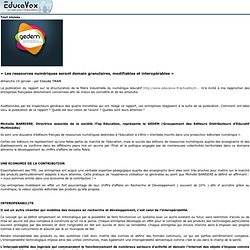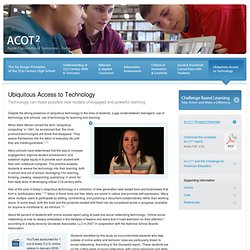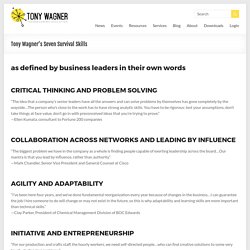

21st Century Literacies: Tools for Reading the World. In Intelligence Reframed Howard Gardner contends that "literacies, skills, and disciplines ought to be pursued as tools that allow us to enhance our understanding of important questions, topics, and themes.

" Today's readers become literate by learning to read the words and symbols in today's world and its antecedents. They analyze, compare, evaluate and interpret multiple representations from a variety of disciplines and subjects, including texts, photographs, artwork, and data. Référentiel de compétences web. Learning {RE}imagined. I’m thrilled to have been chosen to write the next book for the World Innovation Summit for Education (WISE).

« Les ressources numériques seront demain granulaires, modifiables et interopérables » La publication du rapport sur la structuration de la filière industrielle du numérique éducatif m’a incité à me rapprocher des entreprises françaises directement concernées afin de mieux les connaître et de les entendre.

Auditionnées par les inspecteurs généraux des quatre ministères qui ont rédigé ce rapport, ces entreprises réagissent à la suite de sa publication. Comment ont-elles vécu la publication de ce rapport ? Une vidéothèque (presque) idéale de conférences sur le numérique en éducation. Les captations vidéos en ligne de conférences relatives à l'usage du numérique en éducation permettent d'allonger la durée de vie de ces événements et d'élargir leur public au-delà des quelques privilégiés qui ont participé en présence aux évènements.

Le problème avec ces vidéos, c'est évidemment de les trouver, tant les sites qui les mettent à disposition sont éparpillés et volumineux. Pour cette raison, l'effort réalisé par Jeff Tavernier sur son blog doit être salué : il a regroupé sur une même page une trentaine de captations vidéos de grande qualité, réalisées entre 2011 et 2013, classées en 6 rubriques : Why School? TED ebook author rethinks education when information is everywhere. The Internet has delivered an explosion of learning opportunities for today’s students, creating an abundance of information, knowledge, and teachers as well as a starkly different landscape from the one in which our ideas about school were born.

Traditional educators, classrooms, and brick-and-mortar schools are no longer necessary to access information. Instead, things like blogs and wikis, as well as remote collaborations and an emphasis on critical thinking skills are the coins of the realm in this new kingdom. Yet the national dialogue on education reform focuses on using technology to update the traditional education model, failing to reassess the fundamental model on which it is built. Videos Suggested for Back to School Faculty Meetings and other educational audiences. This post could be almost infinite: there is most certainly an extraordinary array of options for videos which expand educators’ understandings and inspire advances in 21st century learning.

But curation is about choice and selection, and while I know I will leave out many, I thought I’d offer up a set of 15 of my favorites for your consideration for video screening at at back-to-school or beginning-of-the-year faculty meetings (and/or parent and board meetings). I’ve starred those that might also serve as useful and engaging videos to share with students at back to school or other assemblies. I am sure every reader will have their own opinions about the videos I’ve left off this list, and please: add them below using the comment box, or, post yourself your own set and share the link from this post to your own. Vhsip [licensed for non-commercial use only] / 21st Century Skills. By Bill Page @Teachers.Net Gazette Bill Page’s book, At-Risk Students; Feeling Their Pain is available through his web sitewww.billpageteacher.com, or through Amazon.com.
![vhsip [licensed for non-commercial use only] / 21st Century Skills](http://cdn.pearltrees.com/s/pic/th/licensed-commercial-century-75681624)
In the midst of the worldwide psycho-neurological revolution, knowledge about the brain and learning is exploding. Teachers don’t need to wait until new brain-mind research reaches down to practical teaching, here are facts teachers can use—now. When information is presented to students, it goes into the working memory of their brain, but the information quickly fades away unless something is done to trigger its move into the brain’s long-term memory, where it can be stored and recalled later. Multiple neurons in various regions of the brain need to fire simultaneously, repetitively, and strongly for information to be readily retrieved and used. A Blended E-learning Environment for Collaborative and Active Learning. ACOT2 - Ubiquitous Access to Technology. Technology can make possible new models of engaged and powerful learning.

Despite the strong presence of ubiquitous technology in the lives of students, a gap exists between teenagers’ use of technology and schools’ use of technology for teaching and learning. When Mark Weiser coined the term “ubiquitous computing” in 1991, he envisioned that “the most profound technologies are those that disappear. They weave themselves into the fabric of everyday life until they are indistinguishable.” Many schools have determined that the way to increase engagement, improve student achievement, and establish digital equity is to provide each student with their own notebook computer. This practice enables students to weave the technology into their learning, both in school and out of school, leveraging it for learning, thinking, creating, researching, publishing; in short; for their daily work of developing critical 21st century skills.
Many of these tools are free. 1 to 1 Programs Work Close. ACOT2 - Ubiquitous Access to Technology. ACOT2. ACOT 2 has identified six design principles for the 21st century high school: Understanding of 21st Century Skills and Outcomes. A Vision for 21st Century Learning. Tony Wagner’s Seven Survival Skills. “The idea that a company’s senior leaders have all the answers and can solve problems by themselves has gone completely by the wayside…The person who’s close to the work has to have strong analytic skills.

Vision for the Future: The Other 21st Century Skills. Due to the interest of my post The Other 21st Skills, I decided to individually discuss each of the skills or dispositions I proposed that are in addition to the seven survival skills as identified by Tony Wagner.

This post focuses on vision for the future. WordPress and Annotum for Education, Science,Journal Publishing. Les TIC, un monde à partager - Éducation. Une invitation à la réflexion et au débat. Une invitation à participer à la mise en place d’un forum très large sur la protection de la connaissance comme bien commun et universel. C’est ce que nous propose Jacques Daignault, professeur au département des sciences de l’éducation, UQAR-Campus de Lévis (Québec) en guise d’ouverture du prochain colloque annuel de l’AQUOPS [1], Association Québécoise des Utilisateurs de l’Ordinateur au Primaire-Secondaire, dont il est le président.
Appli6.hec.fr/amo/Public/Files/Docs/165_fr.pdf. La révolte du pronetariat. The Other 21st Century Skills. Www.edu.gov.on.ca/fre/literacynumeracy/inspire/research/PLC_fr.pdf. New Media Literacies — Learning in a Participatory Culture. Annie Murphy Paul on Why 'Digital Literacy' Can't Replace The Traditional Kind. Have you heard about the octopus who lives in a tree?
In 2005, researchers at the University of Connecticut asked a group of seventh graders to read a website full of information about the Pacific Northwest Tree Octopus, or Octopus paxarbolis. The Web page described the creature’s mating rituals, preferred diet, and leafy habitat in precise detail. New Media Literacies — Learning in a Participatory Culture. The New Media Literacies. The white paper Confronting the Challenges of Participatory Culture: Media Education for the 21st Century (Jenkins et al., 2006) identifies the kinds of participatory practices youth are engaged in today, and draws up a provisionary list of the skills these practices demonstrate. In the video below, members of the NML team share their thoughts and perspectives on the skills we call the new media literacies.